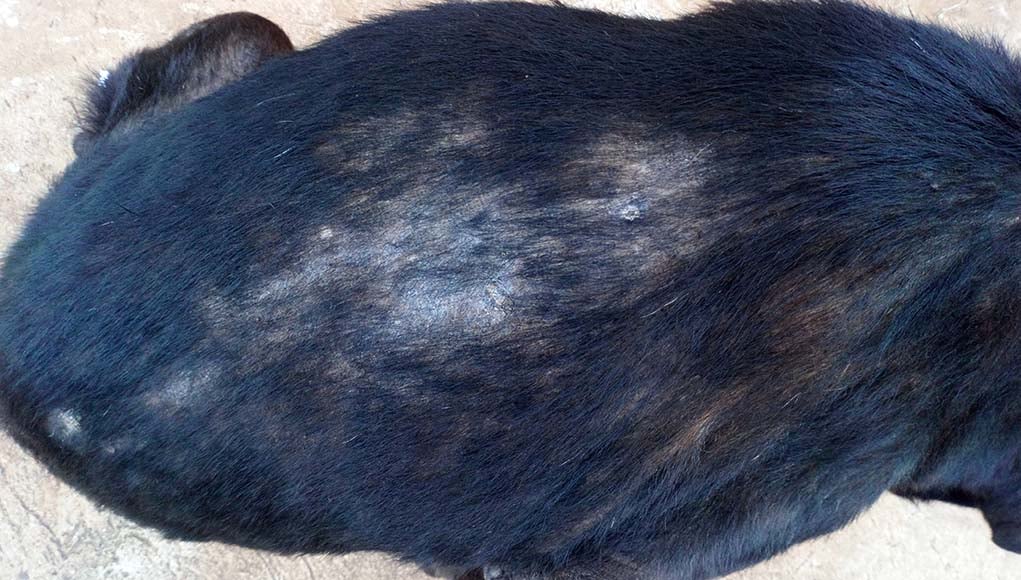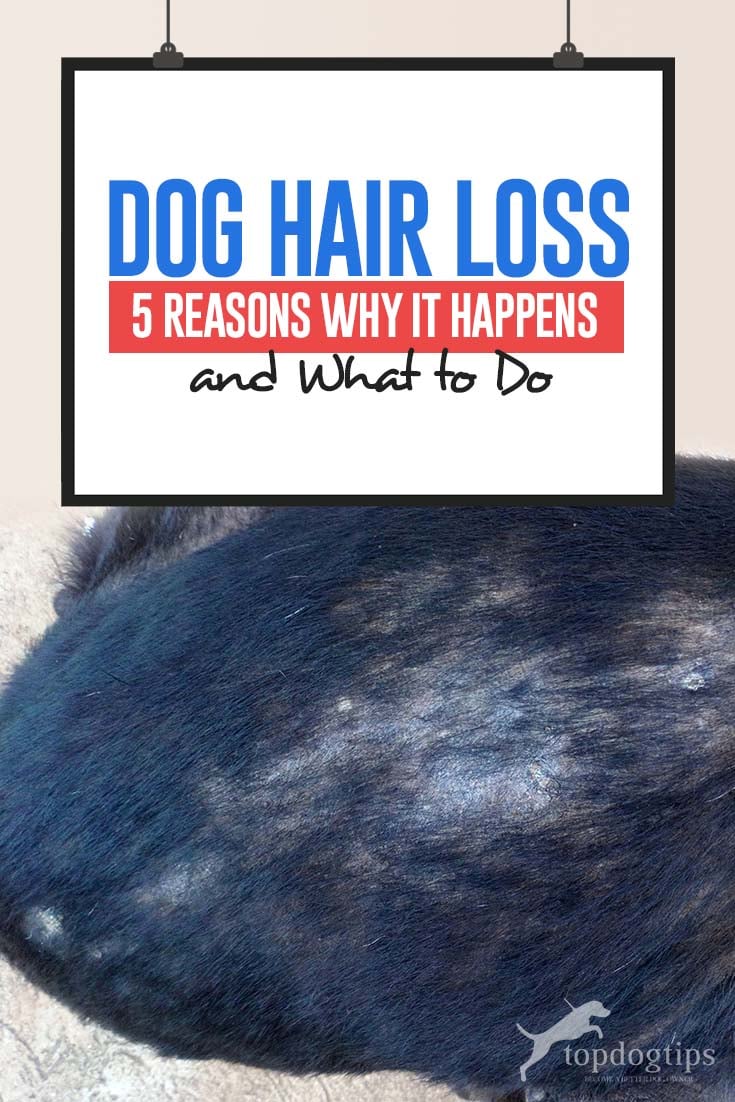Table of Contents
- What Causes Dog Hair Loss?
- When to See a Vet about Your Dog's Bald Spots or Lost Hair
- How to Prevent Hair Loss in Dogs
- Common Questions about Hair Loss in Dogs
- How Can I Treat My Dog's Hair Loss?
- What Diseases Cause Dogs to Lose Hair?
- Is It Normal for Dog's Hair to Fall Out?
- Can Vitamin Deficiency Cause Hair Loss in Dogs?
- How Can I Treat My Dog's Hair Loss Naturally?
- Is Coconut Oil Good for Dog's Hair Loss?
- What Causes Dogs to Lose Hair in Patches?
- READ NEXT: The Best Dog Food for Sensitive Skin
It is not uncommon for a dog to suffer from alopecia, dog hair loss. Or hair thinning and loss. This condition is separate from the natural act of shedding fur.
Shedding is when dogs naturally lose their old or damaged hair, with the amount and frequency depending on health and breed.
Alopecia in dogs, or hair loss, is a common disorder that causes partial or complete dog hair loss.
It can affect your pet's skin and its endocrine system, lymphatic system, and immune system. Alopecia can affect dogs of all ages, breeds, and gender.
For the most part, dog hair loss will be very noticeable to owners, showing up in different patterns and shapes.
It can be sporadic or symmetrical hair loss or maybe shown as bald circles. Both can be accompanied by crusting and inflammation of the dog's skin.
In sporadic cases, the dog may have scaling of the skin too.
ALSO READ: 9 Ways to Improve Your Dog’s Skin and Coat Health
What Causes Dog Hair Loss?
Hair loss in dogs may be caused by many reasons, including allergies, infections, and parasites.
Depending on the underlying cause, canine alopecia may be accompanied by infection and irritation, along with possible reddening of the skin and the affected area.
There are five most common causes of dog hair loss that pet owners will encounter, along with treatments and preventative measures that can assist in caring for your pooch.
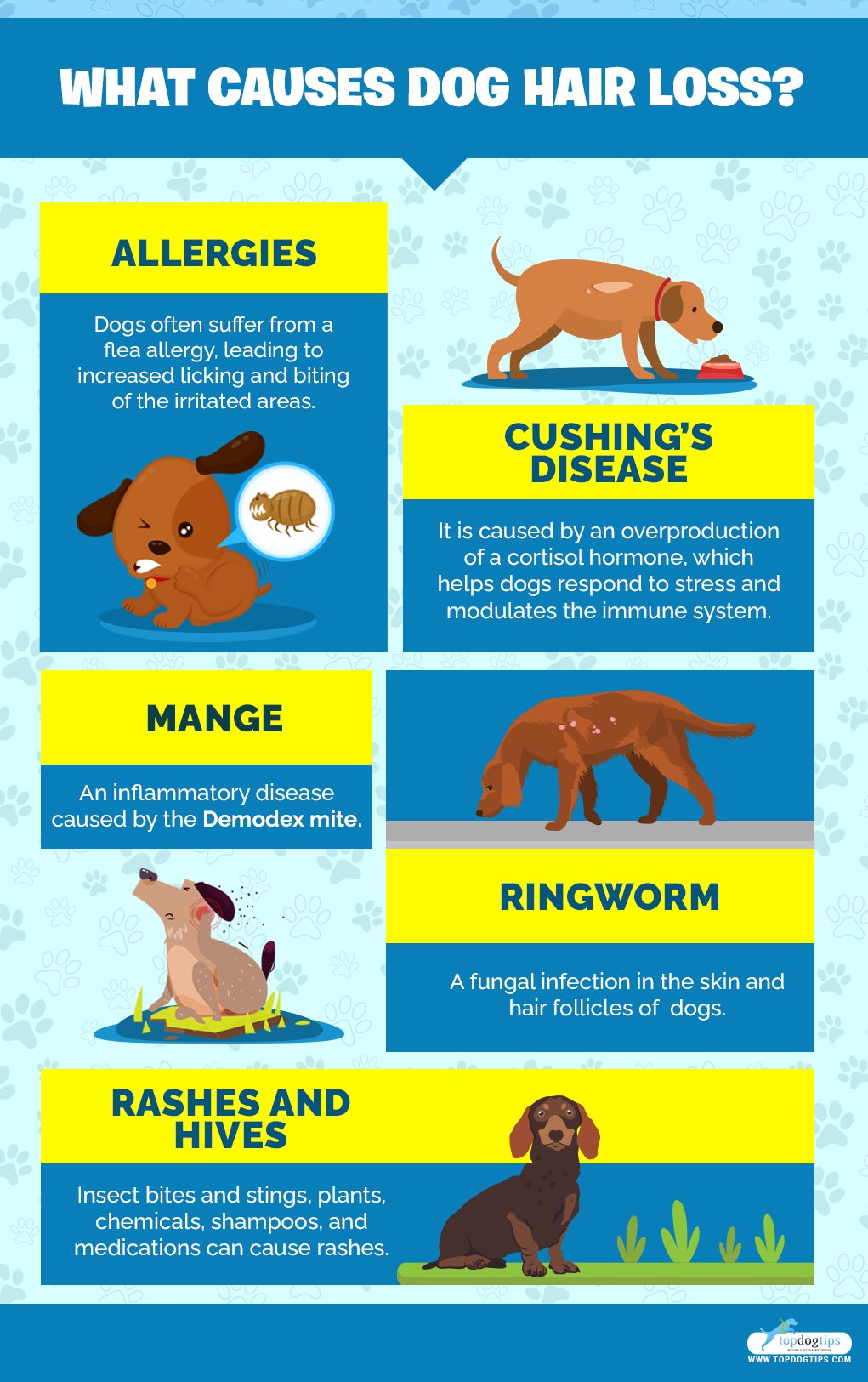
1. Allergies
Allergies are a common underlying cause of many symptoms experienced by dogs. They can trigger pet hair loss whenever the dog has an allergic reaction to their environment, foods, or parasites.
Dogs often suffer from a flea allergy, leading to increased licking and biting of the irritated areas.
The flea bite can create an allergic reaction that can last for days, providing the dog with an extended need to itch, scratch, lick, and irritate the already irritated skin, ultimately causing hair loss.
Discovering the exact allergen can help prevent allergic reactions in dogs. If it is a food allergy, switch brands or food types, or try homemade recipes.
For fleas, take preventative measures such as monthly flea medication; if there is an infestation on the dog, wash your pooch using a flea shampoo and give him a flea-removing oral medication that kills fleas in 2-8 hours.
It may be an environmental allergen. Talk to the vet about starting allergy medication or shots to reduce their irritation.
2. Cushing’s Disease Causes Dog Hair Loss
Hyperadrenocorticism, or Cushing's Disease, is caused by an overproduction of a cortisol hormone, which helps dogs respond to stress and modulates the immune system.
Dog hair loss is not the only symptom of Cushing's Disease – it is usually accompanied by a lack of energy, bruising, obesity, and increased hunger, thirst, urination, and panting.
It mainly affects middle-aged to older dogs rather than puppies or adolescent dogs.
After the vet has officially determined that your pooch has Cushing's Disease, the treatment will vary by how severe the condition is.
If it's caused by medication, they will slowly wean the dog off the medicine.
When the dog is only experiencing mild symptoms, you will monitor it instead of treated it immediately. If the dog's symptoms become worse, a vet will prescribe trilostane.
This medication comes with dangerous side effects, which is why your veterinarian will wait until it is necessary to specify it rather than using it as a preventative measure.
3. Major Dog Hair Loss Occurs With Mange
Mange is an inflammatory disease caused by the Demodex mite.
As the number of mites living in the hair follicles and skin of the dog increases, it can lead to lesions, infections, and dog hair loss.
Mange can either be localized, only affecting specific areas of the dog's skin, or it can be generalized and affect the entirety of your pup's body.
Usually, the mites inhabiting the surface of the dog do not change their hair or skin, but when the numbers grow out of control, it becomes damaging to their fur.
Mange does not require treatment when it is to a small degree. It will usually disappear on its own, doing so spontaneously.
The vet will recommend long-term medications to control the condition whenever it reaches a severe stage, often generalized and not sporadic. If the dog is a female, it should be spayed.
Fluctuations in hormones can exacerbate the symptoms. Changing to high-quality dog food and a low-stress environment may be able to reduce flare-ups.
4. Ringworm
Ringworm is a fungal infection that lives and grows in infected dogs' skin and hair follicles, occasionally infecting the nails.
The infection is normally only a surface infection and only affects a few areas of the dog’s body.
Any dog can get ringworm. It affects puppies, senior dogs, and immunocompromised dogs more intensely. It can lead to widespread ringworm infections on their bodies.
Ringworm is infectious and spreads through direct contact, contaminated objects, and people. Dog hair loss is one of the common symptoms of this condition.
Again, the treatment of this infection depends on its severity, making it a dog-by-dog case.
The vet will usually determine the severity after a physical exam and a diagnostic test using a sample of your pet's hair and/or skin cells.
Typically, the treatment process goes through three steps. First, a vet will suggest topical therapy consisting of either a cream, ointment, or medicated shampoo.
Second, they will prescribe an anti-fungal oral medication to fight the infection.
The third step consists of environmental decontamination.
The removal and cleaning of all loose hairs found on couches, grooming tools, furniture, clothing, and bedding remove the infectious spores.
5. Rashes and Hives Can Cause Dog Hair Loss
Insect bites and stings, plants, chemicals, shampoos, and medications can cause rashes. They can also cause hives on the dog's body and then lead to alopecia in dogs.
These can also include allergic rashes, which are separate from allergies. Allergic rashes and hives typically appear within hours.
Sometimes minutes of exposure, while other symptoms may arise, include listlessness, fever, and vomiting.
The allergic rash or hive-site in dogs often goes bald, causing the hair to fall out.
Allergic rashes and hives require further treatment than simply removal of the allergens. This is often a reaction requiring immediate treatment from the vet to prevent a more substantial, full-body condition.
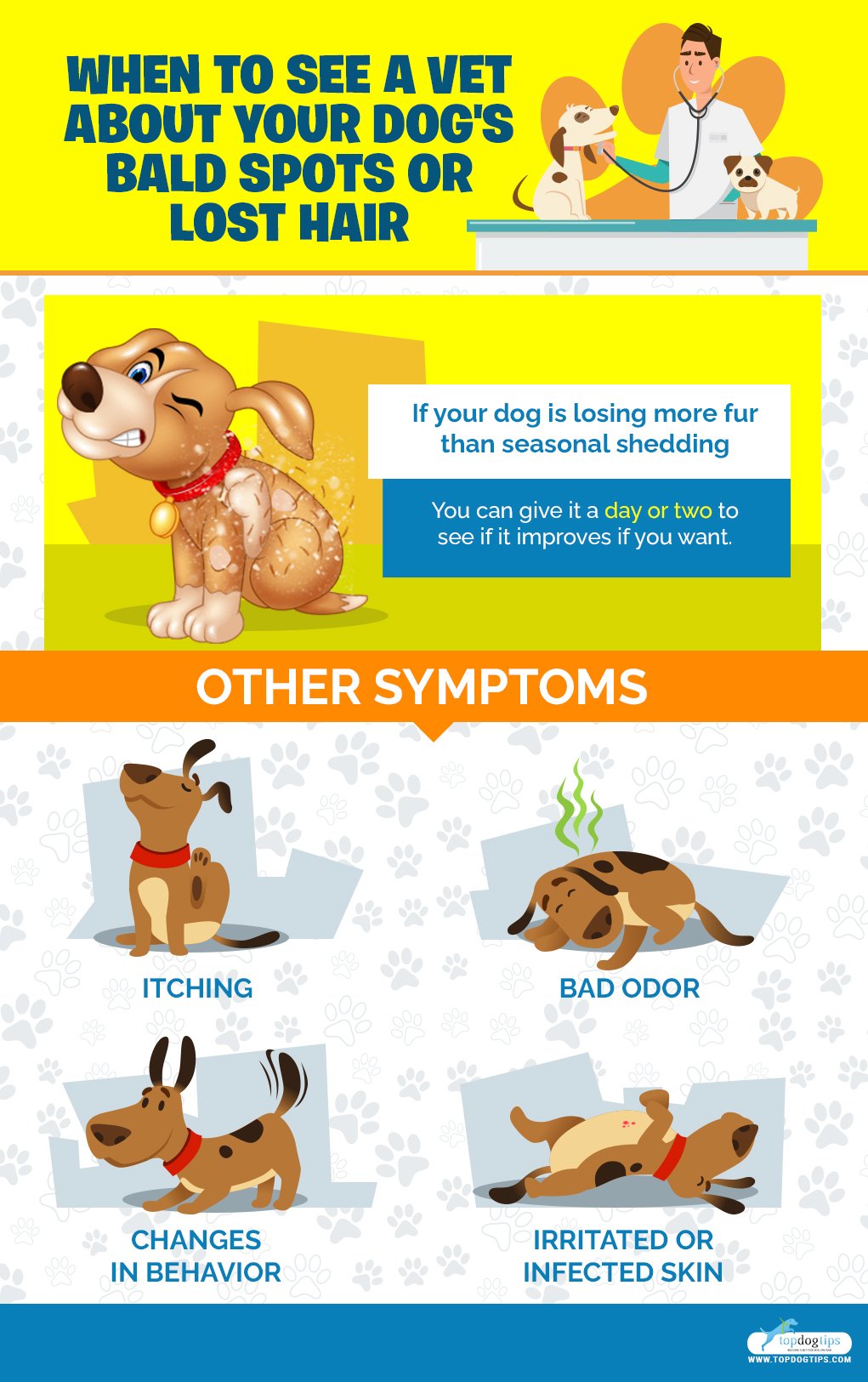
When to See a Vet about Your Dog's Bald Spots or Lost Hair
If your dog is losing more fur than seasonal shedding, then consider consulting your vet. You can give it a day or two to see if it improves if you want.
However, you should definitely make a vet appointment if other symptoms, such as itching, a bad odor, changes in behavior, or irritated or infected skin.
You also want to consult the vet if any other people or pets in the house have skin lesions.
Any situation with itching, bad odor, irritated skin will typically require veterinary medicine.
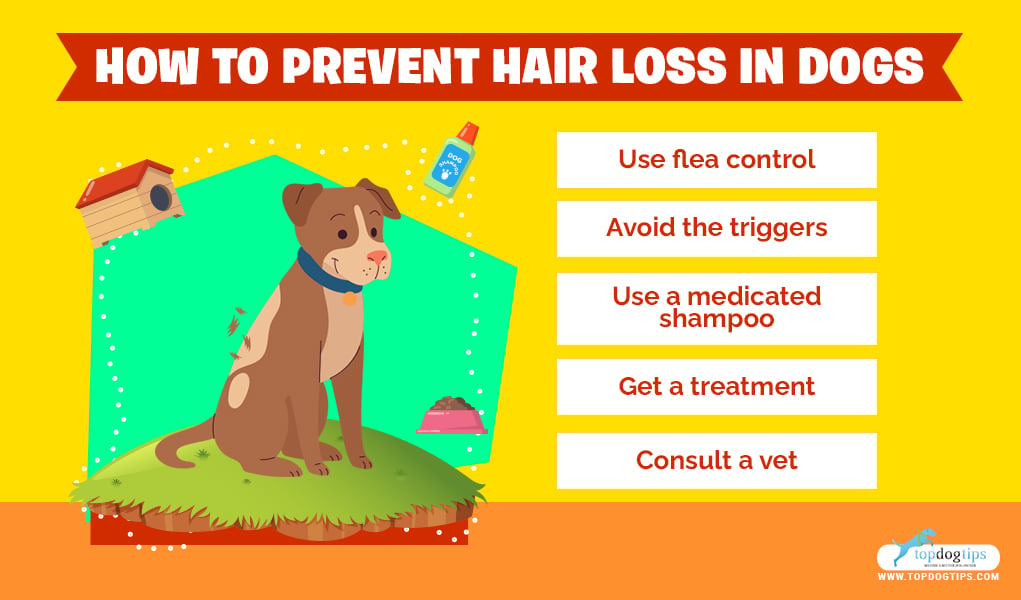
How to Prevent Hair Loss in Dogs
Once you know what can be responsible for a dog losing hair, it becomes easier to prevent it. While you can't stop genetic diseases and certain causes, you can prevent others.
For example, you can use flea control to avoid an allergic reaction to fleas. If your dog has food allergies or environmental triggers, you can avoid the triggers.
If your pup has itchy skin, you can use a medicated shampoo so he doesn't hurt his skin by scratching it.
It would help if you also made it a point to take your dog to a doctor of veterinary medicine at the first sign of hair loss.
This gives them the chance to inspect your dog's coat and treat the inflamed skin or hair loss before it gets worse.
Common Questions about Hair Loss in Dogs
Whether you want the above information in a more concise format or have lingering questions about your dog's hair loss, then the following FAQs should help.
How Can I Treat My Dog's Hair Loss?
If you notice your dog lose hair, your first step should always take him to the vet.
You resolve the issue by identifying and avoiding food allergies or putting your pup on medication in many cases.
Grooming and brushing your dog regularly can also help. That regular grooming will help you notice right away if your dog is losing hair.
What Diseases Cause Dogs to Lose Hair?
From bald patches to full hair loss, several diseases and other causes can lead to your dog losing hair.
Food and environmental allergies are prevalent causes. Infections or infestations of mites, ticks, or fleas are another potential cause.
The hair loss can also be from pressure sores, genetics, Cushing's disease, skin cancer, bacterial or fungal infections, flea bites, skin lesions, mange mites, or dust mites.
Your vet will determine the cause of your dog's hair loss. This will help ensure it is treated properly.
Is It Normal for Dog's Hair to Fall Out?
Some shedding is completely normal but losing more hair than this can be concerning. There is a difference in the amount of hair loss between normal shedding and hair loss.
Hair loss may include skin changes or bald spots. By contrast, seasonal shedding is normal, and your dog will still have healthy skin.
That being said, a dog losing more of its hair coat than from shedding is not too abnormal.
Many dogs experience it at some point. You should, however, consult your vet, especially in the case of extreme hair loss or other symptoms.
Can Vitamin Deficiency Cause Hair Loss in Dogs?
Yes, some vitamin deficiencies can cause your dog to develop hair loss. A zinc deficiency, for example, can lead to hair loss.
It can also cause cracking and skin thickening on footpads and joints. It can also lead to skin ulcers.
If your dog's skin condition is due to vitamin deficiencies, the good news is that this is easy to fix.
With the proper diagnosis, you can change your dog's diet and have his fur back to normal in no time.
How Can I Treat My Dog's Hair Loss Naturally?
One of the most common treatments for losing hair in dogs is medicated shampoos, but some natural remedies can also work.
Apple cider vinegar can be helpful, but you should always dilute it.
Other potential options include aloe vera, vitamin E, and coconut oil. Ideally, you will consult your dog's vet before treating any skin conditions.
Is Coconut Oil Good for Dog's Hair Loss?
Yes, this type of oil is rich in healthy fats that keep your pup's coat beautiful and healthy.
The secret ingredient is lauric acid. Compared to other fatty acids, it is better at keeping fur and skin healthy.
What Causes Dogs to Lose Hair in Patches?
There are several reasons that dogs may experience bald patches. Allergies are prevalent, including environmental and food ones.
Flea bites also commonly cause allergies.
The problem is that there are dozens of things that could lead to your pup's fur falling out. As such, you should see your vet immediately for an accurate diagnosis.
Potential causes include skin infections, food allergies, fungal infections, bacterial infections, flea allergies, hormonal imbalances, yeast infections, dry skin, and other pets.
Your vet will need to confirm no other symptoms, such as mouth patches or irritated skin. He may also request allergy testing.
Then, the vet can use that knowledge to treat the issue at its source.
Veterinary professionals will also likely ask you about changes in your dog's behavior, such as excessive scratching.


